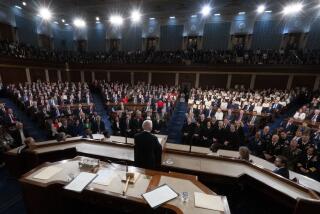A blueprint for Obama on how to fix the economy
- Share via
Here’s the good news about the pageant of economic fecklessness staged this summer by Congress and the White House: The widespread voter disgust it generated improves the chances for President Obama to reset the debate by proposing a set of bold initiatives.
Obama is wrapping up a three-day bus tour of the Midwest to promote a jobs package. Thus far his program’s ambitions are meager indeed, encompassing a $30-billion infrastructure improvement bank and $160 billion from unemployment and payroll tax extensions.
With unemployment at 9.1% nationally and 11.8% in California, a much grander strategy is needed to address persistent joblessness and weak consumer spending.
So here are some suggestions for what Obama should and can do.
1. Fix housing. Several new economic studies show that the worst head wind against economic recovery comes from the dismal state of American families’ balance sheets. Even after years of proliferating foreclosures and cutbacks of credit card balances, household debt today is $11.5 trillion, 2 1/2 times the level of 1999 and on average nearly 120% of disposable income. Three quarters of the total is mortgage debt. That’s a nearly unprecedented drag on household net worth, and one that prevents families from spending at the level needed for recovery.
Yet as I’ve written before, the administration’s homeowner rescue efforts have been pathetic. As part of the $700-billion banking bailout of 2008, about $50 billion was supposed to be devoted to mortgage relief, including nearly $30 billion to the mortgage modification program known as HAMP. Of that sum, only about $2 billion had been spent as of June 30, according to the bailout program’s inspector general. The government made sure that bailout money got to the banks, even some that didn’t want it. But homeowners have gotten barely a taste.
That remaining HAMP money is part of an unspent balance of $53 billion in the bailout program that may still be available for disbursement, according to the inspector general, depending on how it’s used. Obama may not need a further congressional vote to use it. His first order of business should be to dramatically restructure HAMP, say by taking the initiative for mortgage modifications away from the banks, which have done almost nothing but gum up the process. And then put that money to use.
Another idea the White House should get behind is a “right to rent” law that has been kicking around Congress since 2008. Strapped and underwater homeowners facing foreclosure would have to be offered the option of turning over their mortgages to their banks and renting their homes for five-year terms at market rents. At the end of the term they would be offered the option to reacquire the property at its then-market price.
This plan would encourage banks to negotiate modified mortgages more seriously, as banks want to be landlords even less than they want to be real estate owners. It would cut way back on the problem of abandoned or trashed properties, as the foreclosed owners would have an incentive to keep them maintained. It would reduce the cost of housing for affected families to a more rational level, as rents in foreclosure-rich zones have generally fallen well below mortgage payments. And it could be done without any cost to the government.
2. Build! The $30-billion infrastructure bank, which resembles a bipartisan idea that has been kicking around Congress for too long (the co-sponsors are Sens. John Kerry [D-Mass.] and Kay Bailey Hutchison [R-Tex.]) is a start, but only a start. If the public-private partnerships Kerry and Hutchison foresee would really create a gain of more than $600 billion over 10 years for every $10 billion spent from the public till, as they suggest, why take a cheeseparing approach?
A $100-billion fund would create $6 trillion in value, and given the sorry state of the U.S. infrastructure, that would only scratch the surface of what’s needed as an investment in future economic growth. Let’s see Obama put a truly ambitious program on the table, and let’s hear the Republicans in Congress explain why we don’t need the work.
3. Redirect the military budget. Today’s Pentagon spending defines the old saw about the military always fighting the last war. The defense budget in 1963, in the thick of the Cold War, was $51 billion. Accounting for inflation, today’s $700-billion budget is twice that size — and almost all of the increase occurred under George W. Bush. As defense expert Lawrence J. Korb observes, Obama could cut nearly $300 billion from Pentagon spending and still be at about the level reached under Presidents Eisenhower, Nixon and Clinton.
Keeping the money in the economy but reallocating it could yield a true peace dividend: Not only more money for domestic infrastructure, but a revitalized GI Bill for returning service members, educational opportunities for thousands of other Americans, and tax relief for the middle and working classes.
At the moment, many conservative lawmakers hew to the line that federal assistance is creeping socialism if it benefits anyone other than their campaign contributors. (I am indebted to Joseph Heller’s “Catch-22” for the paraphrase.) As the pain of the downturn continues to be felt by the constituents of even the most conservative lawmakers, it’s possible that some of them will be steered away from narrow self-interest and ideological purity and toward wisdom and statesmanship.
This process can be pushed along if Obama places a strong strategic initiative on the table and challenges opponents to explain what’s wrong with it.
An essential step is to remind voters of the scale and nature of the downturn, and therefore the scale and nature of the required response. The administration made a rookie mistake in 2009 by tying its original stimulus proposal to a forecast that unemployment would peak at 8% with stimulus, but rise to 9% without it. The downturn was already making those projections moot, but their relative optimism allowed Washington to rationalize a much smaller stimulus than conditions demanded. And now, of course, congressional resistance to a second stimulus is seemingly implacable.
“They should have done everything they could think of, then as the economy recovered they could have cut back,” says University of Texas economist James K. Galbraith. “Then when the economy did in fact recover then you start trimming back — it’s easy to trim back, but it’s terribly difficult to come back for a second bite of the apple.”
One can judge how much better the economy would look today if the original stimulus had been larger. Economists Alan Blinder of Princeton and Mark Zandi of Moody’s Analytics estimated a year ago that the stimulus would increase 2011 gross domestic product by $1.8 trillion over what it would have been otherwise, accounting for 10 million more jobs and an unemployment rate 6.5 percentage points lower than in an unstimulated economy. Their figures resemble the findings of the bipartisan Congressional Budget Office.
The biggest threat to the economic recovery is Washington’s adherence to the notion that the best way to spur hiring and consumer demand is to do nothing. The self-congratulation displayed by the president and congressional leaders over resolving the debt-limit crisis amounted to their acting boastfully about something they should have been ashamed of.
To quote Heller’s “Catch-22” again: “That’s a trick that never seems to fail.” But Heller was a cynic. The current economic downturn may make realists of us yet.
Michael Hiltzik’s column appears Sundays and Wednesdays. Reach him at [email protected], read past columns at latimes.com/hiltzik, check out facebook.com/hiltzik and follow @latimeshiltzik on Twitter.
More to Read
Inside the business of entertainment
The Wide Shot brings you news, analysis and insights on everything from streaming wars to production — and what it all means for the future.
You may occasionally receive promotional content from the Los Angeles Times.











